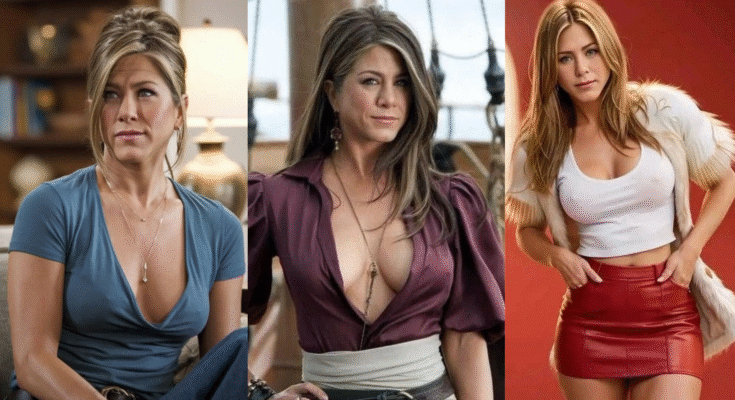The Heart Behind the Hair: Meet Jennifer Aniston
Before she was a global phenomenon, before she was the girl with “the Rachel” haircut, before she became America’s sweetheart—Jennifer Aniston was a struggling actress living in a basement, eating cereal for dinner, and wondering if she’d made a terrible mistake by pursuing acting.
Her journey from obscurity to becoming one of the most bankable and beloved stars in entertainment history is a story about persistence, reinvention, and the power of showing up authentically when the odds are stacked against you.
How a Girl from a Broken Home Became the World’s Most Relatable Star
The Complicated Beginning: Hollywood Royalty Without Belonging
February 5, 1969 – Jennifer Joanna Aniston was born in Sherman Oaks, California, to John Aniston, an actor, and Nancy Dow, a model and actress.
On the surface, Jennifer had advantages many don’t:
Both parents were entertainment industry professionals
Growing up in Los Angeles, the heart of Hollywood
Access to connections and industry knowledge
Cultural capital in a business obsessed with connections
But these “advantages” came with a cost.
Growing Up in the Entertainment Bubble
The Pressure:
Both parents were actors pursuing their own careers
Family dynamics revolved around show business
Achievement and performance were paramount
Love sometimes felt conditional on success
Jennifer learned early that in Hollywood, you’re only as good as your last role
The Unstable Home:
Her parents’ marriage was troubled
They divorced when Jennifer was nine years old
She moved between households
She became the child caught between two parents’ careers
Stability came from neither parent, but from school and friends
The Rejection That Shaped Her
Unlike many children of entertainment parents who are embraced as “industry kids,” Jennifer experienced something different:
The Cruel Irony:
Her father was a working actor
Her mother was a successful model and actress
But Jennifer didn’t automatically follow their path
She had to earn her way, just like everyone else
If anything, being their daughter created higher expectations and more scrutiny
The Early Acting Attempts:
In high school, Jennifer did some modeling and acting
Nothing significant emerged
She felt the pressure to succeed, the weight of her parents’ legacy
But success wasn’t automatic, despite their connections
Finding Escape: Theater and Identity
In high school, Jennifer discovered something powerful: theater.
Like many outsiders, she found in theater a space where she could explore different versions of herself. On stage, she could be someone other than the daughter of actors, other than the girl trying to live up to impossible standards.
The Realization: Theater wasn’t just performance. It was therapy. It was freedom. It was identity.
She knew that acting was what she wanted to pursue, but unlike her parents, she would have to build her career from the ground up.
The Invisible Years: From NYC Waitress to Struggling Actress (1987-1994)
High School and College: The Escape Route
Jennifer attended Fawcett Elementary School, Iman Middle School, and Meadow Wood Middle School, before graduating from Landon School in Maryland.
After high school, she moved to New York City to study at the High School of Performing Arts, then attended the Fawcett School of Drama.
The New York Years:
Moved to New York to escape LA
Wanted to build her career independently
Needed to prove to herself (and her parents) that she could succeed on her own merits
Chose the hardest city and the most competitive environment
The Survival Jobs: The Reality of Struggling Actors
After high school and brief theatrical training, Jennifer faced what all young actors face: nobody wanted to hire her.
The Years of Rejection:
Auditioned constantly, faced rejection consistently
Worked as a waitress at multiple restaurants to pay rent
Worked as a bartender in New York nightclubs
Took any gig she could find to survive
Lived in a basement apartment with barely enough space to breathe
The Financial Reality:
Made barely enough to cover rent and food
Couldn’t afford nicer apartments, so she lived in terrible conditions
Wore the same clothes repeatedly because she couldn’t afford new ones
Made coffee and sandwiches for customers while dreaming of acting
Watched wealthier actresses get opportunities she couldn’t access
The Emotional Toll:
Watched talented people give up and move back home
Questioned daily whether she was foolish to keep trying
Dealt with self-doubt, loneliness, and desperation
Worked restaurant shifts then went to auditions exhausted
Got rejected after rejection after rejection
The Early Television Roles: Paying Her Dues (1990-1993)
Through the late 1980s and early 1990s, Jennifer finally started booking television work:
The Small Roles:
Guest appearances on “Molloy”
Small part in “F.R.I.E.N.D.S” pilot concept that never aired
Appearances on various television shows
Nothing that paid significantly or created career momentum
Each role was a stepping stone, but the path seemed impossibly long
The Moment of Truth: By 1994, Jennifer was in her mid-20s. She had been pursuing acting for years with minimal success. Most people in her position would give up.
The restaurant jobs were more reliable than acting. The steady paychecks would start soon. She could have a normal life.
But then something changed.
The Breakthrough: When Timing, Talent, and Desperation Aligned (1994)
“Friends”: The Accident That Changed Everything
In 1994, the NBC television network was developing a new sitcom concept. The show was initially going to be called “Friends Like Us” and was created by David Crane and Marta Kauffman.
Jennifer auditioned for the role of Rachel Green.
The Role She Almost Didn’t Get:
The producers initially wanted someone else
Jennifer wasn’t the first choice
They tested other actresses
Jennifer had to fight for the part
Even her audition wasn’t considered perfect
But something about her—her vulnerability, her charm, her authenticity—resonated with the producers. They took a chance on the struggling waitress.
“Friends” Premiere (September 22, 1994)
“Friends” premiered on NBC to modest expectations. It was one of several new sitcoms that fall. Nobody predicted it would become a phenomenon.
The First Season Performance:
Aired on Thursday nights
Started with decent ratings but wasn’t immediately a hit
Gradually gained audience loyalty
The chemistry between the six leads was undeniable
Jennifer’s character Rachel Green became the emotional center of the show
Why Rachel Resonated:
She was relatable: young, figuring out life, making mistakes
She was aspirational: beautiful, stylish, independent
She was vulnerable: scared, lonely, trying to find herself
She was real: made bad decisions, fell in love, doubted herself
The Cultural Phenomenon: “Friends” Becomes Unstoppable
By Season 2, “Friends” had become a global phenomenon:
The Numbers:
Moved to a more prominent Thursday night timeslot
Ratings skyrocketed from millions to 30+ million viewers weekly in the US alone
Became the #1 show in television
Maintained that position for most of its 10-season run

Watched in 200+ countries globally
Made Jennifer a household name
The Cultural Impact:
Rachel Green became the most copied hairstyle in history (“The Rachel”)
Fashion trends followed Jennifer’s character’s wardrobe
Catchphrases from the show entered everyday vocabulary
The show defined the 1990s for a generation
Jennifer became the face of the show, though all six cast members were equally important
The Economic Impact:
By season 3-4, Jennifer was earning $25,000 per episode
By season 8-9, she was earning $1 million per episode
Over 10 seasons, earned approximately $30-40 million from the show
This income allowed her to transition to film while maintaining television prominence
The Transition: From TV Star to Movie Star (1996-2010)
The Risk: Leaving the Safety of Guaranteed Income
While “Friends” was a massive financial success, Jennifer faced a career choice:
Stay on television and earn guaranteed millions
Try to transition to film and risk audience perception
Many television stars failed to make this transition
Jennifer’s Risk: She began auditioning for films while still on “Friends” (which filmed in LA in summer months). This required:
Balancing two demanding careers simultaneously
Risking audience backlash if she was seen as abandoning television
Taking on film roles that might not be prestigious enough to matter
Building a film career while in the shadow of television fame
Early Films: Mixed Results (1996-2000)
“Leprechaun” (1993) – Small role before Friends fame “Dream for an Insomniac” (1996) – Limited release “She’s the One” (1996) – Romantic comedy success “Dream for an Insomniac” (1996) – Independent film “Picture Perfect” (1997) – Romantic comedy “Dream for an Insomniac” (1996) – Film work balanced with TV
The Reality:
Early film work was inconsistent
Romantic comedies and light roles
Critics questioned if she could do serious work
Some roles were critically panned
But each film built her film credentials
The Turning Point: Taking Serious Roles
“Object of My Affection” (1998):
Dramatic role exploring complex emotions
Showed she could handle mature, sophisticated material
Critically well-received
“Dream for an Insomniac” (1996) – Independent film released later “The Good Girl” (2002):
Dark, independent film
Complex character far from Rachel Green
Critical acclaim
Proved she could do challenging material
“Along Came Polly” (2004):
Box office success
Balanced commercial appeal with character depth
Film Success (2005-2015)
As “Friends” ended and Jennifer focused fully on film, she built an impressive filmography:
“Marley & Me” (2008):
$200+ million box office
Emotional, character-driven film
Showed her range with dramatic material
“He’s Just Not That Into You” (2009):
Romantic comedy ensemble success
$300+ million worldwide
“Management” (2008) – Romantic film “Derailed” (2005) – Thriller “Rumor Has It” (2005) – Comedy-drama
“Cake” (2014):
Critical acclaim
Complex, dark character
Showed artistic commitment
“Horrible Bosses” franchise:
Commercial success
Comedy showcase
Box Office Dominance
By 2010-2015, Jennifer Aniston had become one of Hollywood’s most bankable film stars:
Consistent box office success
Films regularly grossed $100-300 million worldwide
Became the “go-to” actress for romantic comedies and light dramas
Built a loyal audience that followed her from role to role
The Real Achievement: The “Rachel” Haircut Phenomenon
One of the most remarkable aspects of Jennifer’s career emerged unexpectedly:
The Rachel Effect:
In 1997, Jennifer’s character Rachel Green got a new hairstyle designed by Chris McMillan—a layered, highlighted cut that became known as “The Rachel.”
The Impact:
Women worldwide copied the hairstyle
Became the most requested haircut in history
Created a cultural phenomenon independent of her acting
Remains iconic 25+ years later
Shows her influence extended beyond entertainment into fashion and lifestyle
The Significance: This wasn’t planned or manufactured. It emerged organically from her character on television. It shows the power of authentic cultural influence—when something resonates genuinely, it creates ripples beyond entertainment into everyday life.
Personal Life: The Public and Private Struggle
The Pressure of Fame: Privacy Stolen
Jennifer’s personal life became as scrutinized as her professional life:
The Challenge:
Every relationship was public fodder
Every dating rumor became tabloid headlines
Her romantic life was dissected on national television
Privacy became nearly impossible
Major Relationships: The Public Narrative
Brad Pitt (2000-2005):
Married the quintessential Hollywood leading man
Their couple name “Brangelina” became cultural phenomenon
When they divorced, it dominated global headlines
Media portrayed Jennifer as the wronged party
Their separation became one of the biggest celebrity news stories of the 2000s
Justin Theroux (2011-2017):
Long-term relationship
Married in 2015
Divorced in 2017 after years of relationship difficulties
Again, the media dissection was relentless
Personal Choice:
No children, by choice
Focused on career rather than traditional family structure
Made unconventional life choices for a female celebrity
Faced criticism for not having children, contrary to societal expectations
The Real Impact: Jennifer’s romantic life was never truly hers. Every relationship was commodified, analyzed, and used for tabloid consumption. She had to live her personal life in public, with millions of strangers invested in her romantic happiness or failure.
The Maturation: From TV Star to Cultural Icon (2010-Present)
Returning to Television: “The Morning Show” (2019-Present)
After years focusing on film, Jennifer returned to television with Apple’s “The Morning Show.”
The Significance:
Top-tier television production
Substantial pay and creative control
Showed she could do dramatic television work
Proved that television wasn’t just where she came from—it was where she could thrive
The Performance:

Critical acclaim
Complex dramatic role
Demonstrated continued growth as an artist
Showed that at 50+, she was still evolving
Social Media Dominance
Jennifer embraced social media late but with significant impact:
Instagram Success:
Joined Instagram in late 2019
First post with all six “Friends” cast members broke records
Over 40 million followers
Uses platform authentically
Shows her personality beyond entertainment industry
The Cultural Shift: From Youth to Wisdom
As Jennifer aged, something remarkable happened:
The Reversal:
Instead of fading as she got older, she remained prominent
Instead of being devalued as beauty faded, she became more respected
Instead of being sidelined, she became an elder stateswoman of entertainment
At 50+, she was more powerful and respected than at 30
This stands in stark contrast to typical Hollywood trajectories for women.
The Secret Behind Jennifer’s Unstoppable Success
Lesson 1: Authenticity Over Perfection
Jennifer’s greatest asset isn’t her acting technique. It’s her authenticity. She brings genuine vulnerability to her roles. Rachel Green is beloved because Jennifer made her real, flawed, and relatable—not because she’s a technically perfect actress.
Lesson 2: Persistence Through Years of Invisibility
Jennifer didn’t become famous until her late 20s. For years, she was a struggling waitress nobody knew. Most people give up before that breakthrough. Jennifer kept showing up.
Lesson 3: Balance Between Commercial and Artistic Work
Jennifer didn’t just do romantic comedies. She also did serious, independent films. She balanced commercial success with artistic credibility, proving she could do both.
Lesson 4: Reinvention Across Decades
From television to film to returning to television, Jennifer adapted her career as the industry changed. She didn’t cling to what made her famous. She evolved.
Lesson 5: Surviving Celebrity Culture
Jennifer navigated one of the most intrusive, judgmental celebrity cultures imaginable. She maintained her sanity and humanity while being constantly scrutinized and dissected.
Lesson 6: Aging Authentically
Rather than fighting aging or disappearing like many actresses, Jennifer aged visibly, honestly, and powerfully. She became more interesting as she aged.
The Numbers: A Career Measured in Impact
Television:
10 seasons of “Friends” (238 episodes)
236+ million viewers per week at peak
Watched in 200+ countries
Made her a global phenomenon
Earned $30-40 million from the show
Film:
40+ theatrical films
Multiple films grossing $100-300 million worldwide
Consistent box office success
Built a $250+ million net worth
Awards and Recognition:
Emmy Award nomination for “Friends”
Golden Globe wins
People Magazine’s “Most Beautiful” multiple times
Ranked among highest-paid actresses multiple years
Social Media:
40+ million Instagram followers
Most-followed female celebrities globally
The Journey: Before & After
AspectThe Struggling Actress (1987-1994)The Global Icon (1995-Present)
Financial Status
Barely surviving, living in basement
$250+ million net worth
Career Status
Unemployed/waitressing
Global superstar
Recognition
Nobody knew her name
Most recognized woman in world
Opportunities
Fighting for any role
Choosing from top scripts
Income
Minimum wage
$1 million per episode at peak
Social Status
Struggling nobody
Cultural icon
Housing
Basement apartment
Multiple properties
Personal Life
Private, anonymous
Public property
Influence
None
Created global trends
Longevity
Uncertain future
30+ year career
The Bottom Line: Why Jennifer’s Story Matters
Jennifer Aniston’s journey from basement-dwelling waitress to global phenomenon proves something fundamental:
Authenticity, persistence, and luck combined create unstoppable momentum.
She wasn’t the most technically gifted actress. She wasn’t born with golden connections. She wasn’t beautiful in a way that opened doors automatically.
What she had was: ✓ Willingness to do unglamorous work (waitressing) ✓ Persistence through years of rejection ✓ Authenticity that audiences could feel ✓ Vulnerability that made her relatable ✓ Willingness to evolve and take risks ✓ Resilience in an industry obsessed with youth ✓ Ability to age authentically ✓ Cultural instinct about what people wanted to see
Key Takeaways for Dreamers and Strivers
✨ Struggling years aren’t wasted years—they’re foundation-building years ✨ Overnight success often takes 10+ years of invisible work ✨ Your breakthrough might come from unexpected places ✨ Authenticity is your greatest asset in a world of performance ✨ You can transition between different types of success ✨ Aging doesn’t have to mean fading ✨ Balance commercial success with artistic integrity ✨ Persistence through years of “no” leads to eventual “yes” ✨ Relatability is more powerful than perfection ✨ Your personal life doesn’t define your professional value
Jennifer Aniston’s Defining Words
“For what it’s worth, it’s never too late or, in my case, too early to be whoever you want to be. There’s no time limit, start whenever you want.”
“I think it’s important to take your work seriously, but not take yourself too seriously.”
“The hardest thing about being an actor is staying happy.”
“The struggles along the way are only meant to shape you for your purpose.”
The Continuing Evolution
In her 50s, Jennifer continues to work at the highest level:
Quality television and film roles
Social media presence that feels authentic
Influence that extends beyond entertainment
Role model for aging authentically
Continued career evolution without desperation
This is the real Jennifer Aniston story:
Not a woman who got lucky once and coasted on that success. But a woman who:
Struggled for years before her breakthrough
Built a career across multiple mediums
Evolved with changing industry and audiences
Maintained authenticity throughout massive fame
Aged powerfully instead of fading
Remained relevant for 30+ years
In an industry obsessed with youth and disposability, Jennifer Aniston proved that authenticity, persistence, and evolution create lasting impact.
That’s why, decades after “Friends” ended, audiences still watch her. Still care about her. Still see themselves in her.
Because she’s never stopped being real.



